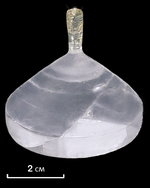| Search for content and authors |
Czochralski growth of 2" BaBrI crystals |
| Evgeniy Galenin , Sergey Gridin , Viktoriia V. Romanchuk , Sergey Vasyukov , Alexander Gektin |
|
Institute for Scintillation Materials NAS of Ukraine (ISMA), Lenina ave., 60, Kharkov 61001, Ukraine |
| Abstract |
Modern need in equipment for prevention of radioactive terrorism is a driving force for development of scintillation detectors with improved characteristics, first of all, high light yield and energy resolution. BaBrI host is considered as one among the most promising for activation with Eu2+. Recently, it has been demonstrated that BaBrI:Eu possesses a high light yield about 100000 ph/MeV and excellent energy resolution 2,55% (137Cs), fast scintillation decay (~500 ns) relatively to other alkali earth halides [1]. The main problem limiting development and application of such materials is a high hygroscopicity. BaBrI is less hygroscopic relatively to LaBr3, SrI2, CsBa2I5 hosts. BaBrI:Eu, as well as other alkaline earth halide crystals, are usually grown by Stockbarger method in evacuated ampoules in order to prevent oxidation. Crystals grown by this method are limited in diameter by ampoule size and normally do not exceed 1" - 1.5" in diameter. Absence of a seed does not guarantee growth orientation and structure perfection of grown crystals. They often crack due to adhesion to the material of ampoules. This work is devoted to development of the Czochralski (CZ) growth technology of BaBrI. At current stage the growth conditions are optimized for 2" diameter ingots. A specific technique preventing raw material interaction with atmospheric air at uploading of raw material into the crucible was utilized. Influence of radial temperature distribution in the crucible on the crystal-melt interface shape is studied. It is shown that the radial gradient of 15-20 K/cm leads to growth interface convexity and deterioration of crystal quality. Reduction of the radial gradient down to 5 K/cm leads to flattening of the crystallization interface and provides stable conditions of pulling for 2" diameter crystals (see fig.1.) 
Figure 1. BaBrI 2" diameter CZ grown crystal. Presence of oxygen-containing impurities was estimated by IR transmission measurements. The grown crystals have the absorption band at 880 cm-1 and 1410 cm-1 corresponding to CO32-. The luminescence spectra demonstrate a set of bands ranging from 400 to 550 nm, which is in agreement with spectroscopic measurements made with undoped crystals obtained by the Stockbarger technique [2]. [1] E.D. Bourret-Courchesne, G. Bizarri, at al., Nuclear Instruments and Methods in Physics Research, A 613 (2010), 95–97. [2] R. Hawrami, J. Glodo, E.V.D. van Loef, at al., IEEE Transactions on Nuclear Science, doi 10.1109/TNS.2013.2240696. |
| Legal notice |
|
| Related papers |
Presentation: Oral at 17th International Conference on Crystal Growth and Epitaxy - ICCGE-17, General Session 2, by Evgeniy GaleninSee On-line Journal of 17th International Conference on Crystal Growth and Epitaxy - ICCGE-17 Submitted: 2013-04-04 15:06 Revised: 2013-07-19 19:09 |